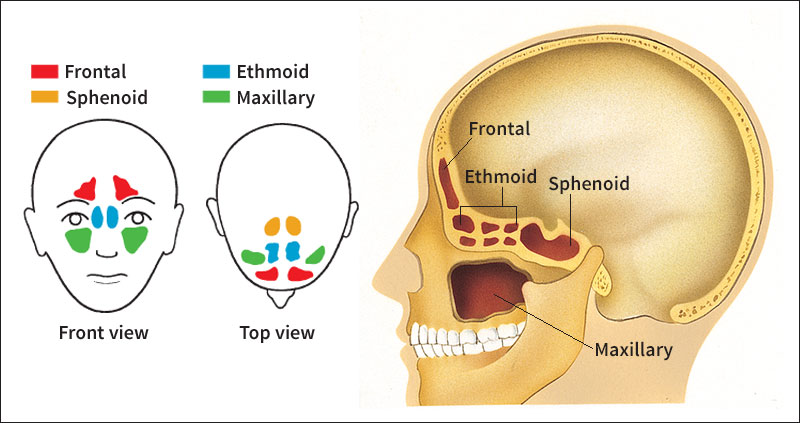Sinus, << SY nuhs, >> is a cavity in the bodies of animals, including human beings. When used alone, the term sinus generally refers to a hollow, air-filled space in the front of the skull. The human skull contains four groups of sinuses. Doctors sometimes call these groups the paranasal sinuses, because they all connect with the nasal cavity. Each group of sinuses takes its name from the bones of the skull in which it is found.

The frontal sinuses are in the frontal bone of the forehead just above the eyes. The maxillary sinuses, largest of the paranasal sinuses, are located in the cheekbones on each side of the nose. The ethmoid sinuses lie just above the nasal cavity, and the sphenoid sinuses are behind them. The sinuses lighten the skull, and make it easier to hold up the head and to balance it on the neck. They also cushion the brain from blows to the front of the skull.
The sinuses are lined with the same kind of membranes as those that line the nose (see Membrane). Infections of the nose spread easily to the sinuses. There, the infection causes a disease commonly called sinus trouble, or sinusitis. In sinusitis, the inflamed mucous membranes in the sinuses become swollen, closing the opening and preventing infected material from draining out. When this happens, painful pressure builds up in the sinuses. This pain may occur at the same time every day. Other symptoms of sinus trouble may include dizziness and a running nose. Allergies, colds, influenza, and many other diseases frequently result in sinus symptoms. Other factors that may make some people more susceptible to sinusitis include dampness, drafts, and smoking.
The treatment of sinus trouble includes rest and liquid diet. Antibiotics and pain-relieving drugs are helpful. Sometimes surgery may be used to puncture a maxillary sinus and permit proper drainage, or to remove the abnormal sinus membrane. Sinus trouble is dangerous because it may serve as a center of infection that spreads to other parts of the body, such as the eye or brain.
Sinuses occur only in mammals, birds, and crocodiles. The huge sphenoid sinus of the elephant extends to the very back of the skull.
